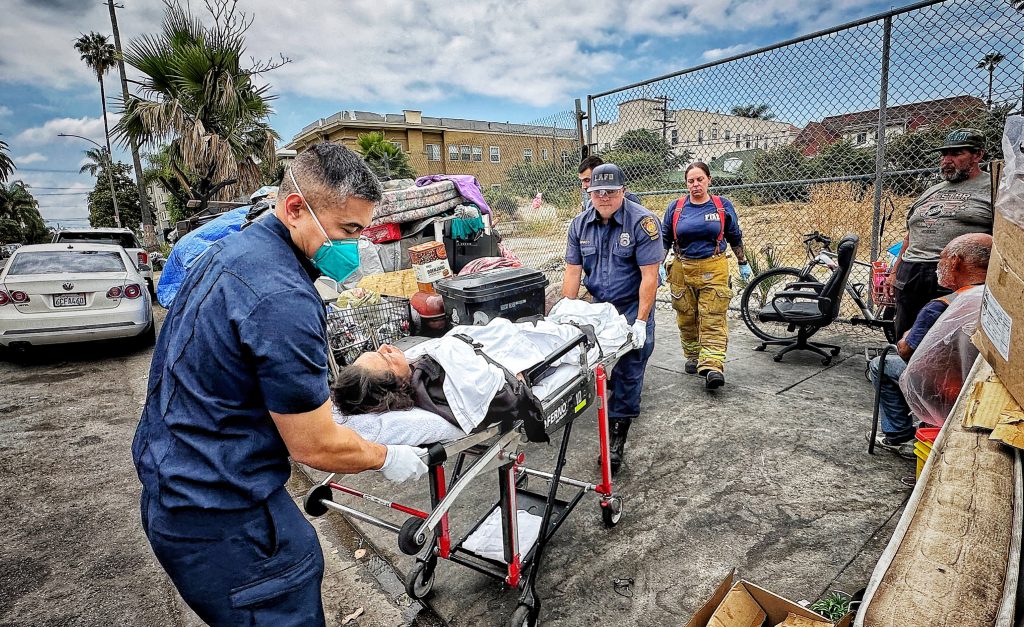
The 100-foot stretch of West 10th Street that fronts the shop, located at Olympic Boulevard and Gramercy Place in Koreatown in Los Angeles, is home to one old camper, four tents, and one barracks-style tent.
A homeless man has also set up his shelter on the corner of the 76 gas station next door.
“Before COVID-19, homeless people moved in one by one, and they now have been staying for more than two years. Piles of garbage and the smell of urine interfere with our business.”
“We used to let homeless people take tap water, but now we refuse to do so. I hope the city government will provide them with shelter soon.”
On New Hampshire Avenue between Wilshire Boulevard and 6th Street, where the LA Consulate General is located, five homemade tents, two barracks-style, and three smaller ones, have been set up for over a year.
The homeless people here are also taking care of “street sweeping,” cleaning the area around the tents themselves.
“They do nothing,” said Oden, a homeless man in his 30s. “I was in a housing program and had to leave a year ago. Now the shelter says there is no room.”
In December 12, 2022, LA Mayor Karen Bass declared a state of emergency on homelessness on her first day in office.
She immediately signed an executive order to build low-income supportive housing, reducing or eliminating unnecessary regulations for homeless shelters, permanent housing, and more.
At the time, she promised to do everything she could to address the issue of homelessness.
In May 2023, Mayor Bass extended the state of emergency on homelessness.
She said the city’s $50 million “Inside Safe” program has turned 25 hotels and 22,437 rooms into temporary shelters for the homeless.
The L.A. City Council also streamlined approvals for more than 15 housing projects.
But half a year later, it’s hard to see much change on the streets in Koreatown.
What has changed in Koreatown is that while there are fewer clusters of homeless tents due to enforcement and street cleaning, there are more small groups of tents scattered throughout the alleyways.
I walked around town from last weekend through the 12th to check it out.
The street between Chateau Park Recreation Center 4 and Chateau Place, once home to more than 20 homeless tents, now has only two tents left.
Only one tent remained at the LA Baptist Church at 8th and Westmoreland Avenue, where there were about 10 tents.
The tent camp on Sunset Place at the Korean Education Center in Los Angeles, which had more than five tents, has been cleared.
The 5th Street and Virgil Avenue encampment is also gone, with only one homeless man taking a nap.
The largest encampments currently are the Olympic Boulevard and Gramercy Place encampments and the LA Consulate General Street encampment, each with five to six tents.
Although the clusters have dwindled, it’s still easy to find one to three tents in the area.
There are tents at every intersection, especially along 6th Street, the main dining district in town.
There are homeless people on almost every block: two RVs on the south side of Berendo Street, three tents on the north side of Mariposa Avenue, three tents on the south side of Ardmore Avenue, three tents on the south side of Harvard Boulevard, one tent on the south side of Hobart Boulevard, and one tent on the south side of Manhattan Place.
Homeless people we spoke with in the tents cited a lack of information and barriers to accessing shelter or supportive housing.
Jose Dillion, 30, who has been living in a self-made tent on the north side of 6th Street and Mariposa Avenue, said he has been here for a year.
“My LA County Homeless Services Authority (LAHSA) case manager told me I should be able to get into a shelter or hotel, but there are no openings,” he said.
“Even Hope at Lafayette (Wilshire Boulevard and Hoover Street), the Koreatown shelter, is hard to get into. Temporary housing would help me stabilize and change my life.”
“I think about half of the homeless in Koreatown are Korean,” said Sunsu Jeon (63) who has been homeless for three months at Olympic Boulevard and St. Andrew’s Place.
“The shelters have set hours and are not flexible, so they stay for a day and don’t go back. The police do check on tents in Koreatown, but it’s safer than downtown.”
Meanwhile, according to LAHSA’s 2022 State of Homelessness Report, 69,144 people are homeless in LA County, of which 41,980 are LA residents.
Of the 27,345 homeless complaints filed with MyLA311, between January 1 and June 7, 926 (3.3%) were filed in the Wilshire Center-Koreatown Neighborhood Council’s (WCKNC) jurisdiction, which includes Koreatown.
This is the fourth-highest among the 99 neighborhood councils in Los Angeles.
“We estimate that there are about 200 homeless people living in Koreatown, and about 30 percent of them are Korean,” said Maria Cho, an associate pastor at Father’s Table Mission, a homeless support organization.
BY HYOUNGJAE KIM, SUAH JANG [support@koreadaily.com]





